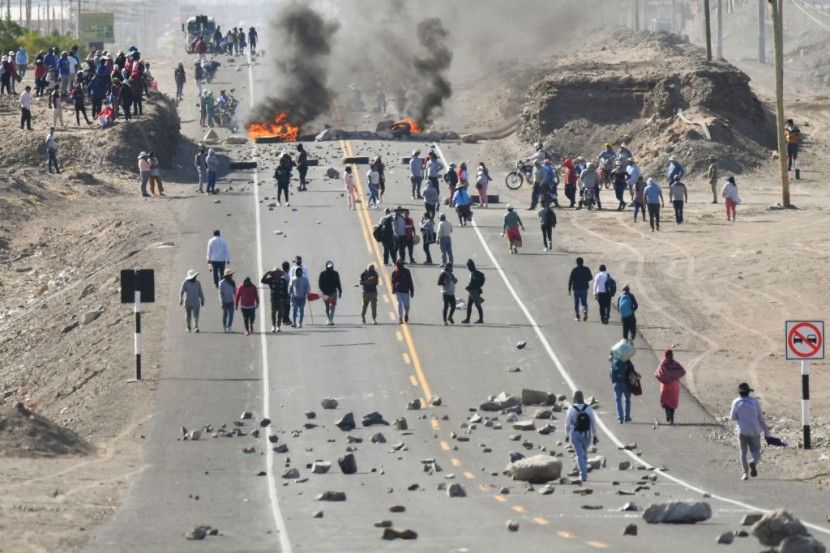
The removal of previous leftist President Pedro Castillo a month ago sparked the ongoing turmoil, which has taken at least 41 civilian deaths and one police officer in Peru.
The Congress of Peru, supported by the opposition, voted to remove Castillo from office on December 7, after he attempted to "temporarily" dissolve the legislature and govern by decree before the third impeachment attempt of his troubled administration.
Peru Protests' Cause
His former vice president, Dina Boluarte, succeeded Castillo upon his impeachment. Protesters have demanded Boluarte's resignation, and many are also demanding early elections and the release of Castillo, who is in pre-trial incarceration on charges of "rebellion" and "conspiracy." He denies the accusations.
Mid-December, the new president proclaimed a countrywide 30-day state of emergency to quell the demonstrations, restricting key civil freedoms and authorizing the deployment of Peruvian security forces. Boluarte has also advocated "peace, tranquility, and unity," Al Jazeera reported.
However, protests have persisted, and on January 9, at least 17 protestors were slain in southern Peru on the worst day of violence so far. Human rights organizations have accused officials of deploying weapons and smoke bombs against protestors. According to the army, demonstrators utilized guns and improvised bombs.
On Tuesday, Amnesty International asked the Peruvian government to cease the "unnecessary and disproportionate use of force" against civilians following the deaths of civilians in the country's south, a base of support for Castillo, a former rural teacher and union leader.
The 17 victims were put to rest on Thursday in Juliaca, a city in the southern Puno area near the Bolivian border where demonstrators attempted to seize the airport earlier in the week. Due to the demonstrations, train and air ties to Peru's famous Machu Picchu monument were severed on Friday.
Thursday saw the death of a 16-year-old who was shot during a demonstration in the southern Peruvian region of Puno, raising the death toll to 49 since the resignation of President Pedro Castillo. Relatives of the kid, identified by the initials B.A.J. by Peruvian officials, claim he was hospitalized in serious condition for two days after being shot in the head.
His death brought the total number of protest-related fatalities in the Puno area, home to Lake Titicaca, to 19. A police officer assaulted and burnt to death by a gang of demonstrators is among the deceased. The death toll from the demonstrations in Peru currently stands at 49.
The Ombudsman's Office said on Thursday that there were mobilizations, strikes, and barricades in 35 Andean provinces, primarily in the south, as per ABC News.
In the city center of Lima, hundreds of protesters demanded the resignation of President Dina Boluarte, the dissolution of Congress, and rapid elections. Despite calls for Castillo's release, he remains incarcerated. The governors of Puno, Cusco, and Apurmac have demanded that Boluarte step down.
In Cusco, the Inca citadel Machu Picchu location, a group of protestors attempted to set fire to the police headquarters, but officials were able to extinguish the flames. Other protesters stormed the Antapaccay mining site and set fire to two vehicles.
In the southern district of Apurimac, locals demonstrated outside the entrance of the Las Bambas copper mine. A group from the Inter-American Commission on Human Rights arrived in Puno to collect information on the demonstrations and the socioeconomic problems.
The upheaval began in early December due to the impoverishment and detention of Castillo, Peru's first president from humble, rural origins, when he attempted to dissolve Congress and prevent his impeachment. Boluarte served as Castillo's running partner before assuming the presidency. She has supported moving the previously scheduled 2026 presidential and congressional elections to 2024.
She has also voiced support for judicial inquiries to determine if security officers used excessive force. However, these measures have thus far failed to quiet the discontent.
Protesters have blocked highways, set buildings on fire, and infiltrated airports, resulting in millions of dollars in property damage and lost income. Blockades have interrupted commerce, stopped planes, and left visitors stranded. The security forces' response has been violent. There have been people who were not protesting among the victims.
The Inter-American Commission on Human Rights has criticized both police and protester brutality and urged for discussion. Protesters have thus far declined to engage in dialogue with Boluarte.
Read Also: Shinzo Abe Murder Update
Who is Pedro Castillo?
In 2021, voters elected Castillo, a socialist, from a crowded field of candidates, following years of political instability and a pandemic that devastated Peru more severely than any other nation.
Castillo, a little-known teacher and union leader from an impoverished Andean hamlet, needed elected office experience and links to the Lima elite. Castillo's supporters hoped he would improve the representation of poor, rural, and indigenous Peruvians while standing up to the elites, according to NBC News.
Once in government, however, corruption scandals, party infighting, and legislative opposition eroded his popularity. Castillo struggled to govern during his brief administration, appointing five prime ministers and more than eighty ministers.
Castillo has maintained sympathy from those who view him as a victim of unpopular and corrupt political elites and Congress. In a November IPSOS survey, Castillo's favor rating of 27% was still higher than Congress' approval rating of 18%.
Related Article: Peru Protest: Officer Burns to Death in Patrol Car
@YouTube
© 2025 HNGN, All rights reserved. Do not reproduce without permission.








